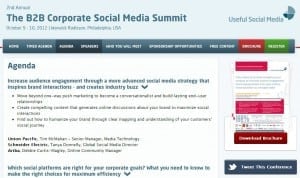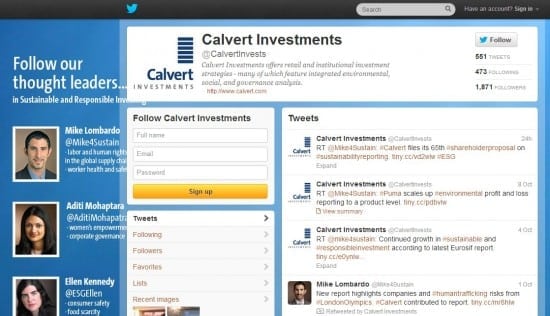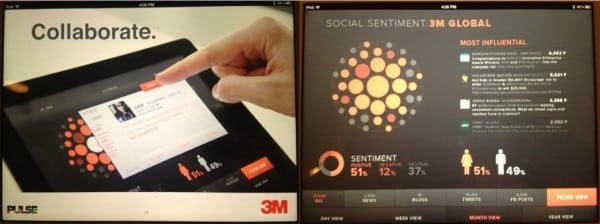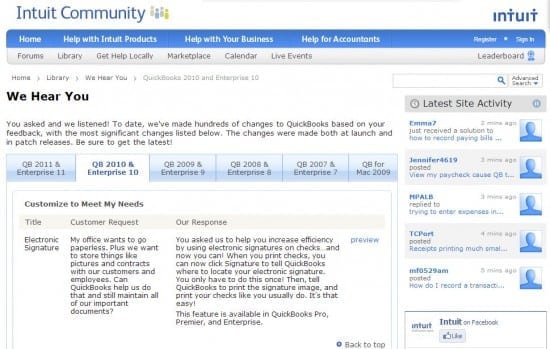
Thankfully, the #1 topic of discussion that came from the B2B Corporate Social Media Summit (follow the conversation at #CSMB2B) taking place yesterday and today in Philadelphia is something that any brand cares about even more than reputation … sales. Social selling, as it is now being called, is a way of describing social media activities that have a direct (rather than indirect) impact on sales. In some cases, it may involve driving online sales through ecommerce (particularly for B2C products and services). In the B2B world, however, social selling often comes down to lead generation.
The summit featured brand speakers from SAP, 3M, Citi, Steelmaster, Sage, United Pacific and many other large brands. Throughout the first day, many of them shared some unique insights about what social selling really means and how to use those lessons to drive sales. Here is a recap of some of the most memorable ideas from the first day of the summit:
1. Create a library of resources and internal success stories.
Almost every B2B brand has dedicated sales people – but the challenge most organizations face is how to properly engage these sales people through social media. Christine Talcott, VP of ES Global Sales at ADP shared a brilliant case study of some of the useful resources that they offer to sales staff to enable them to more effectively do their jobs. They use everything from videos and training to internal case studies of “converted” sales people who talk about how much of an impact social media has had on their selling. The result is a strong pipeline of positive examples, as well as a ready toolkit for sales people to draw upon.
2. Get smarter about content creation.
In one of the most powerful case studies of the day, Michelle Wickum, Director of Marketing from Steelmaster shared a story of how her pre-fabricated steel structure manufacturer was struggling with a 49% decrease in lead volume and 39% sales decline. She worked to adopt a more content-centric strategy and used that content to answer key customer questions and grow engagement. In her industry and category, this was a strategy no other competitor was using … which allowed Steelmaster to dramatically grow its share of voice. Ultimately, the combination of her content and focus on social media helped result in a 92% increase in lead volume and 79% increase in sales revenue. When asked how much social media actually contributed to that figure, and whether she was able to measure that impact, she shared that she was, and between 30% and 40% of the turnaround could be attributed DIRECTLY to social media.
3. Foster internal creators first.
Your people are your best spokespeople. For all the times that we hear this wonderfully cliched piece of advice, how many companies actually manage to find a great way to inspire those people to talk about your business. In a session later in the day, marketing manager Annie Cull from Calvert Investments shared how her internal program to foster and develop what she termed “SMACs” (Social Media Approved Contributors) led to a strong and engaged group of employee ambassadors. In the same session, Matt Anchin from Nielsen spoke about how his organization has build a speaker’s bureau of more than 350 experts who can speak about Nielsen research … and now that group is increasingly turning to social media as a way to share their insights in between speaking gigs.
4. Let the doers try (and sometimes fail).
Control is a topic that nearly always comes up at any social media event – and when you consider operating a brand on a global basis, the issue is one that most large brand teams have struggled with at some point. The usual response is to create some sort of centralized guidelines for best practices, and perhaps even some kind of “center of excellence.” Tanya Donnelly, Global Social Media Director of Schneider Electric shared a somewhat different strategy. Instead of sucking employee ambition and passion with crippling guidelines, she encourages some amount of experimentation with highly visible metrics. In other words, she lets people try new things, but makes their failure or success highly visible. As a result, there is an incentive for smart experimentation with a strong strategy, and a disincentive to take unfounded risks.
5. Make collaboration the priority.
In a sneak preview of a presentation he will deliver next week at the Pivot conference, 3M Social Media Leader Greg T. Gerik showcased some very interesting innovations at 3M that are all focused on fostering more collaboration for multiple business reasons. One reason, of course, is to inspire better research and more innovation. There were plenty of applications for social selling and insights gathering as well. Below are several screens from this new tool, which includes online automated sentiment analysis, and even real life installations of touch screens in the main 3M office to encourage more virtual collaboration across sllos.
6. Listen to and act on customer suggestions.
The owner of Quickbooks and TurboTax was one of several brands that has both a B2B AND a B2C operation. As a result, they have the unique chance to take lessons from what works in one situation and apply another. For Intuit, as Sherry Ramatian discussed, this means taking reviews from customers and using them to shift opinions and inform potential customers prior to a sale. In addition, when customers have suggestions for improvements, Intuit works hard to not only listen, but also share any results that may come from those suggestions.
7. Build relationships before you need them.
An often repeated stat from multiple presenters throughout the day was that 60% of all B2B sales purchase decisions are made based on the pre-sales cycle. In other words, more than half of the purchase decision is already made before your prospect even lets you know they are interested. To account for this fact, Gerry Moran, Social Media Marketing Director from SAP shared several stories of how his organization builds relationships with potential clients through showcasing customer stories and creating and sharing content of value. The goal, as Gerry shared, is to “shift from focusing on lead generation” to “demand generation.” The end result is that when a customer is finally ready to consider a new solution – SAP is at the top of the short list.











WE RECENTLY REMOVED COMMENTING - LEARN WHY HERE >